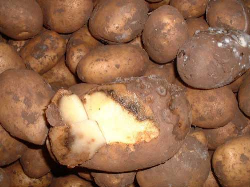
Preventing tuber blight in potatoes requires a planned approach from emergence through to lifting. Effective control relies on keeping blight out of the crop through the use of an effective foliar blight programme, followed by the planned, integrated use of fungicides with confirmed zoospore activity from tuber initiation onwards, advises Dow AgroSciences.
"Tuber blight can cause up to 40% yield loss plus down grading or rejection of the sample. It is the primary cause of fungal wastage in store. There are also the hidden costs of this disease; for example grading costs of £15 per tonne. It is important therefore that the blight spray programme, from start to finish contributes to the prevention of this damaging and costly disease. Growers should not ease up on blight protection, even though it has been dry and warm in July. Action on tuber blight should not be left to the end of the programme, because low levels of foliar blight earlier in the season can lead to high incidence of tuber blight. The best policy is to adopt an integrated approach against tuber blight using cultural and chemical methods of control," advises Andy Leader, Principal Biologist for Dow AgroSciences.
"Firstly it is important to plant uninfected clean seed and to remove any nearby sources of infection such as dumps and volunteers. We are approaching the optimum time to apply Fazor (maleic hydrazide) in the growing crop, which will reduce volunteers in any following crop, so forward planning is important. Then you need to maintain a robust foliar blight programme, applying treatments regularly, shortening the spray interval in high risk conditions. Whatever the weather conditions, it is vital that you include repeat sprays of products with known zoospore activity from stable canopy onwards right through to lifting,"
Dow AgroSciences Limited, Latchmore Court, Brand Street, Hitchin, Herts SG5 1NH
Tel: 01462 457272 Fax: 01462 426605
"The motile twin-tailed zoospores that are produced in the sporangia on the leaves are responsible for causing tuber blight. They tend to be produced any time in the crop's development when the temperature is below 15° C. Each infected leaf can produce many zoospores when the conditions are right. Zoospores drop or are washed down from the leaves and stems to the soil where they propel themselves in the soil water. They infect potato tubers by germinating close to the tubers and entering at easy access points such as buds, lenticels or wounds. Tubers with a thin coverage of soil, or those growing in cracked soils, or those brought into contact with zoospores during the lifting operation are liable to infection. Once inside the tuber, the fungal mycelium spreads and causes breakdown of cellular tissue. Symptoms are normally seen within one month of lifting," explains Andy Leader.
"Zoxium (as in Electis) prevents zoospore formation and release, resulting in the production of malformed spores, incapable of infecting tubers. Other fungicides act on zoospores once they are released. Fluazinam in Shirlan paralyses zoospore flagella, cyazofamid in Ranman inhibits zoospore respiration and fluopicolide in Infinito disrupts membrane proteins in zoospores and so the alternation of Electis with such complementary products in a programme will provide excellent protection against tuber blight. You only need a few zoospores to be formed and released to the soil for tubers to suffer significant and damaging blight infections. This approach was confirmed in British Potato Council trials. Programmes containing Electis (zoxium and mancozeb) with other zoospore killers gave the best control of both foliar and tuber blight."
